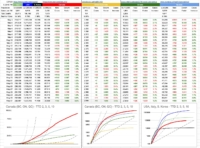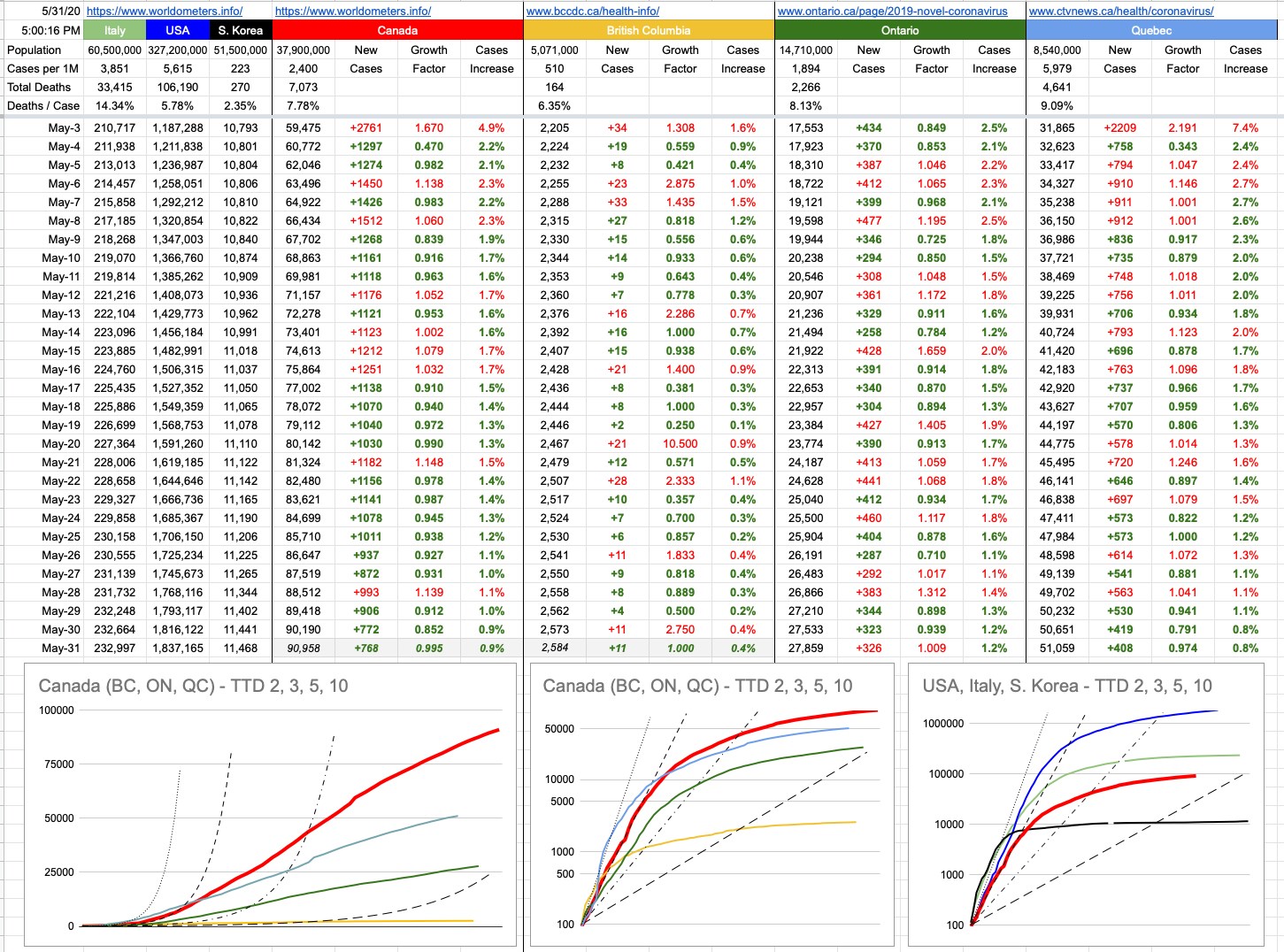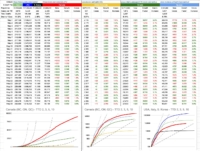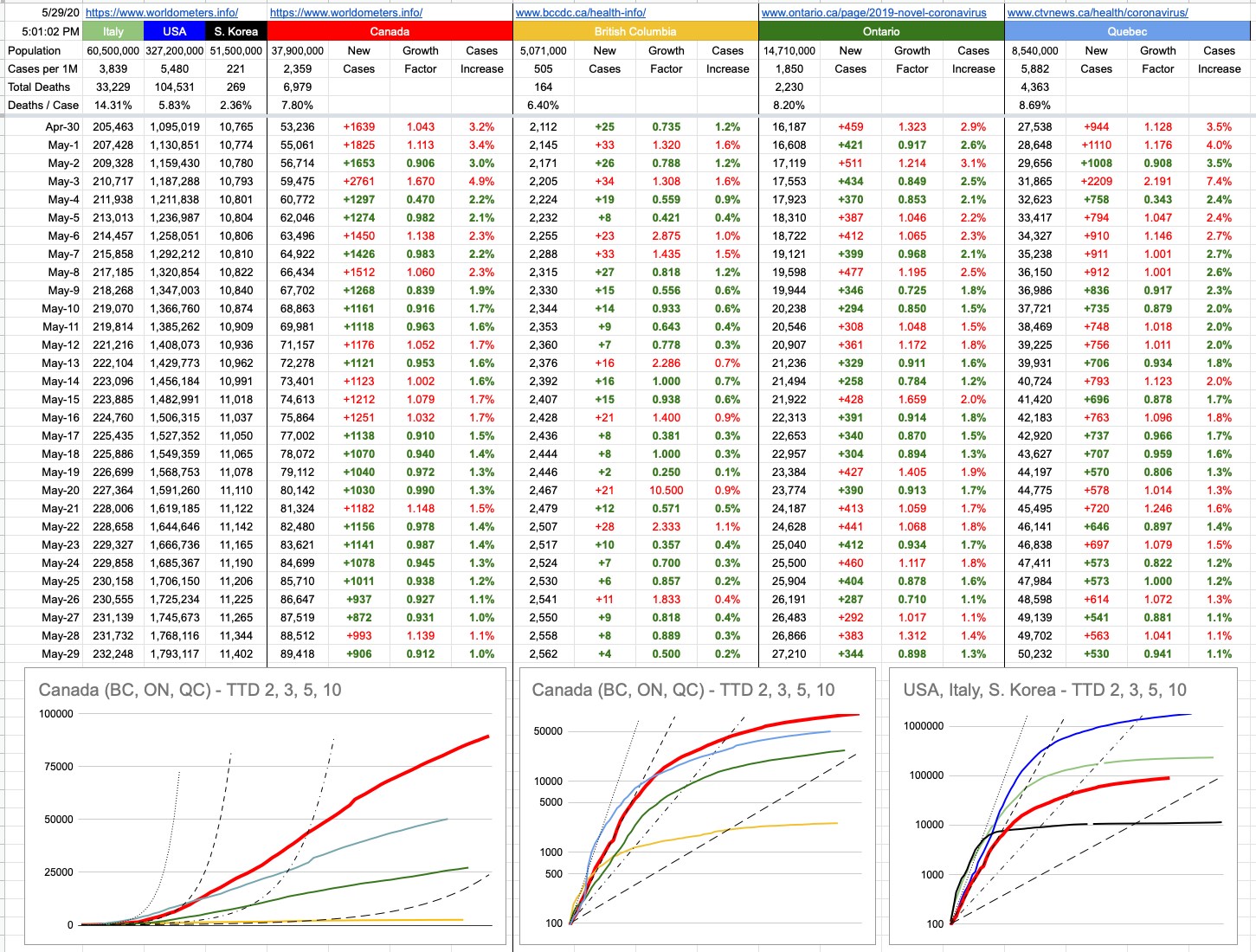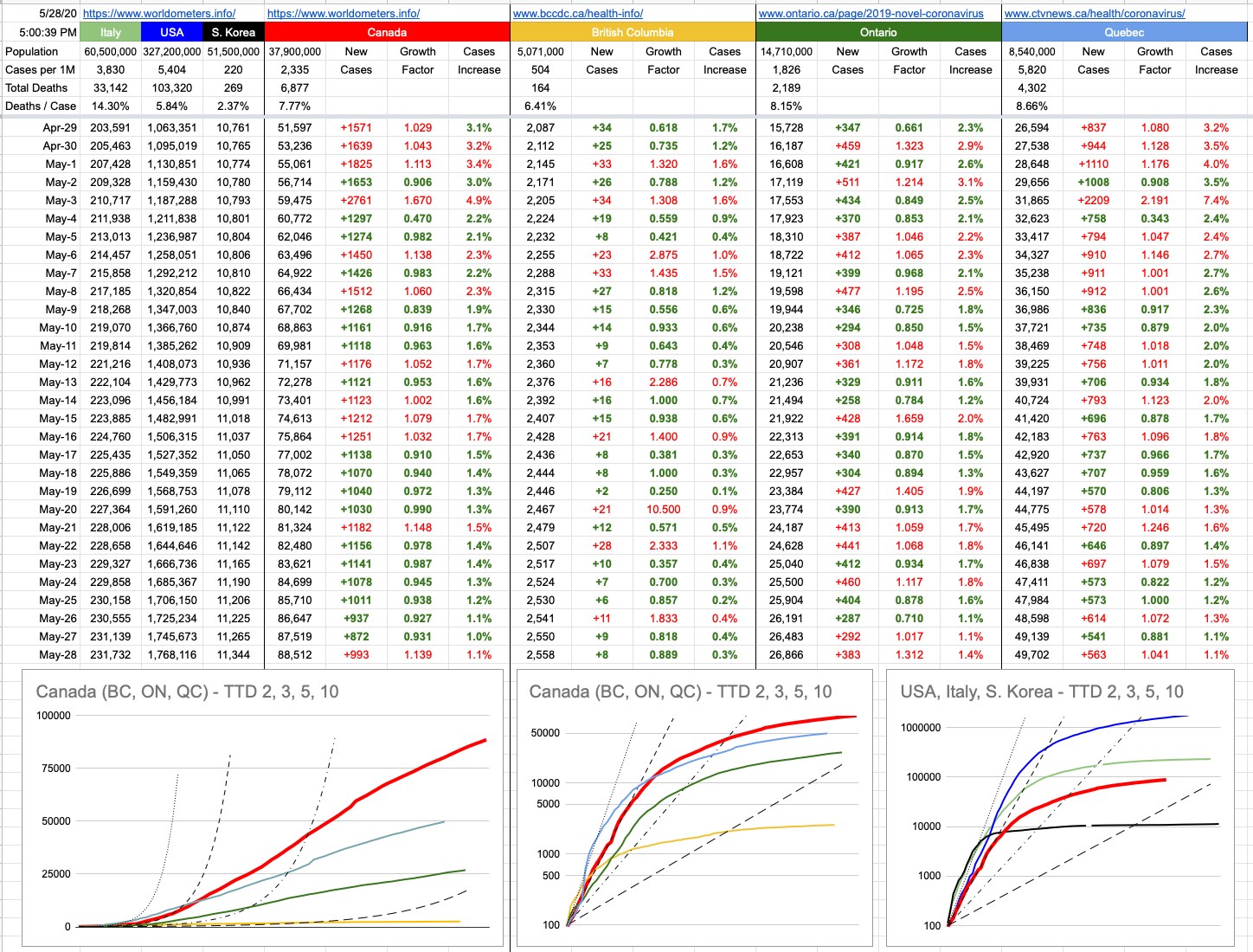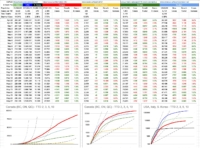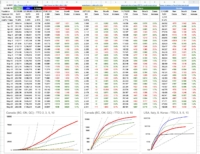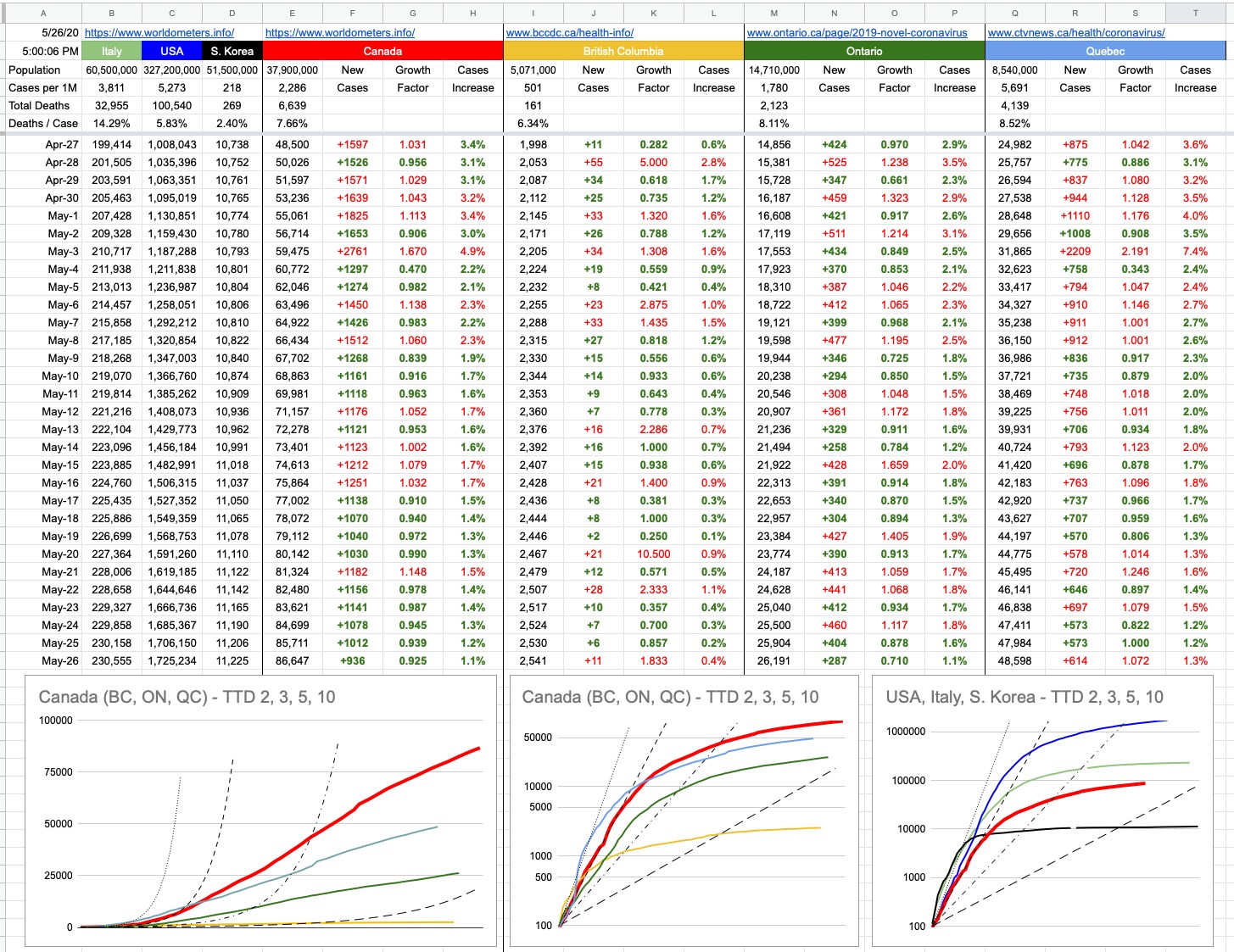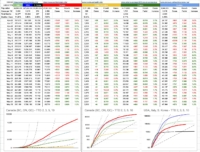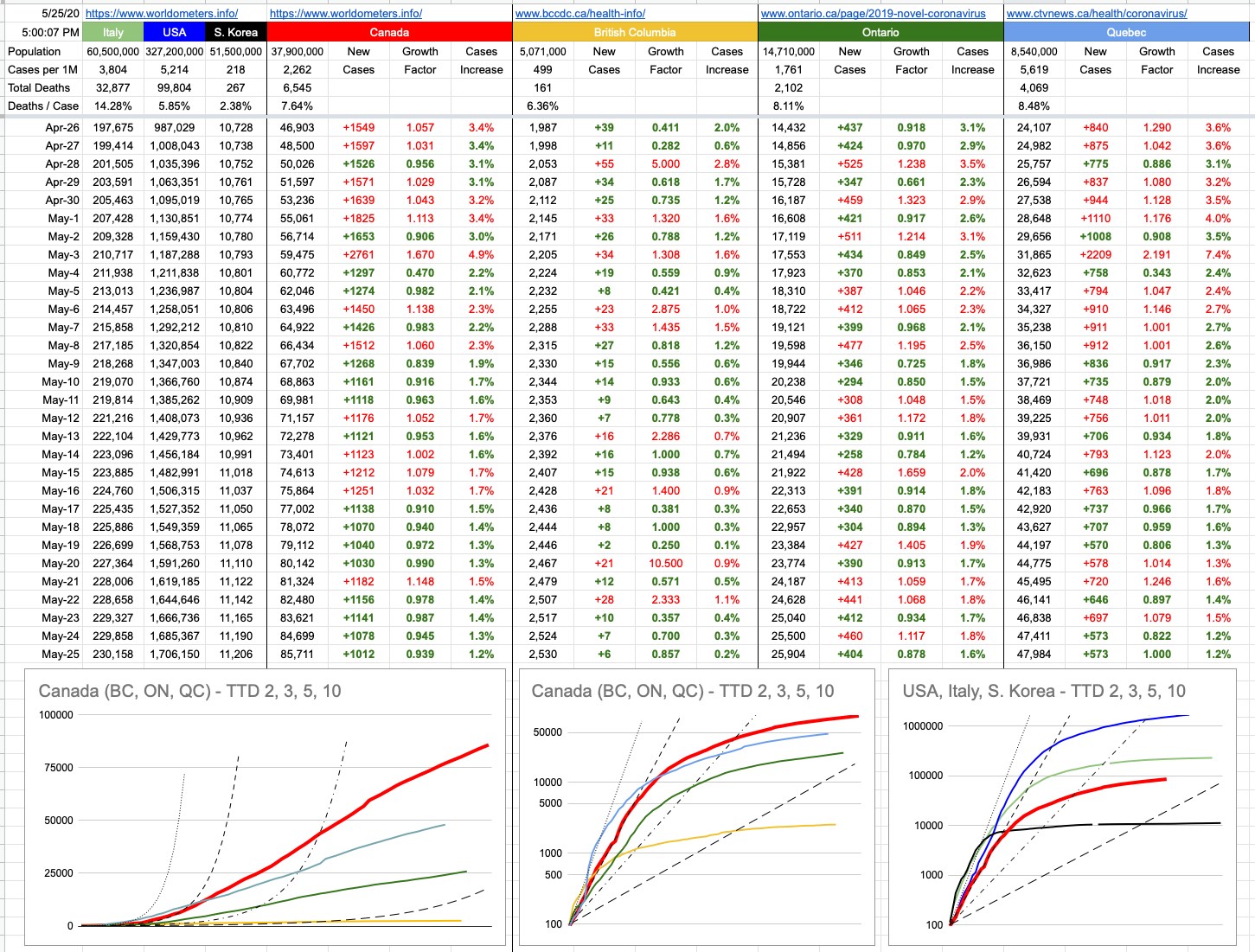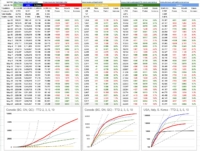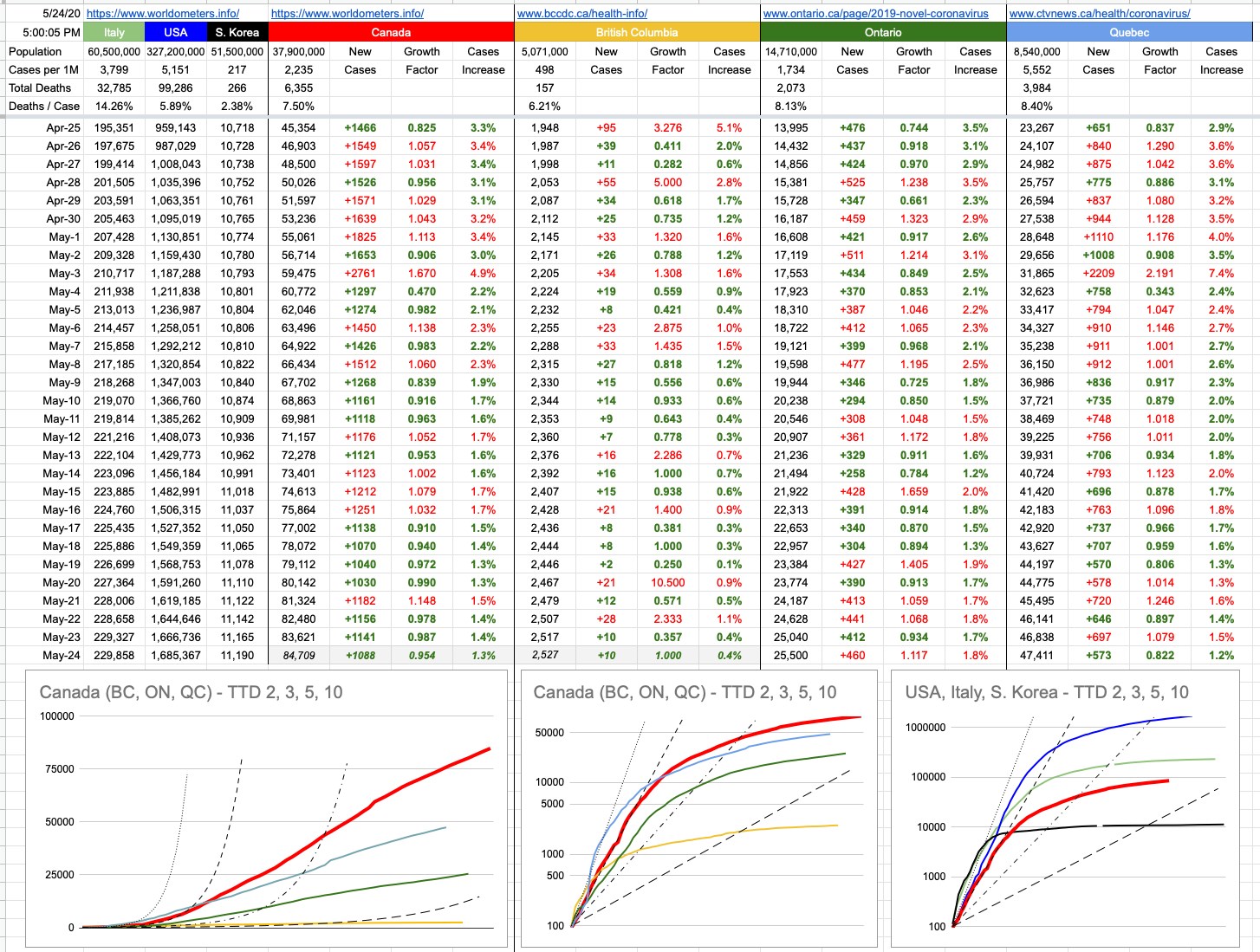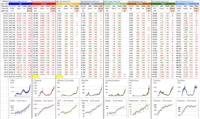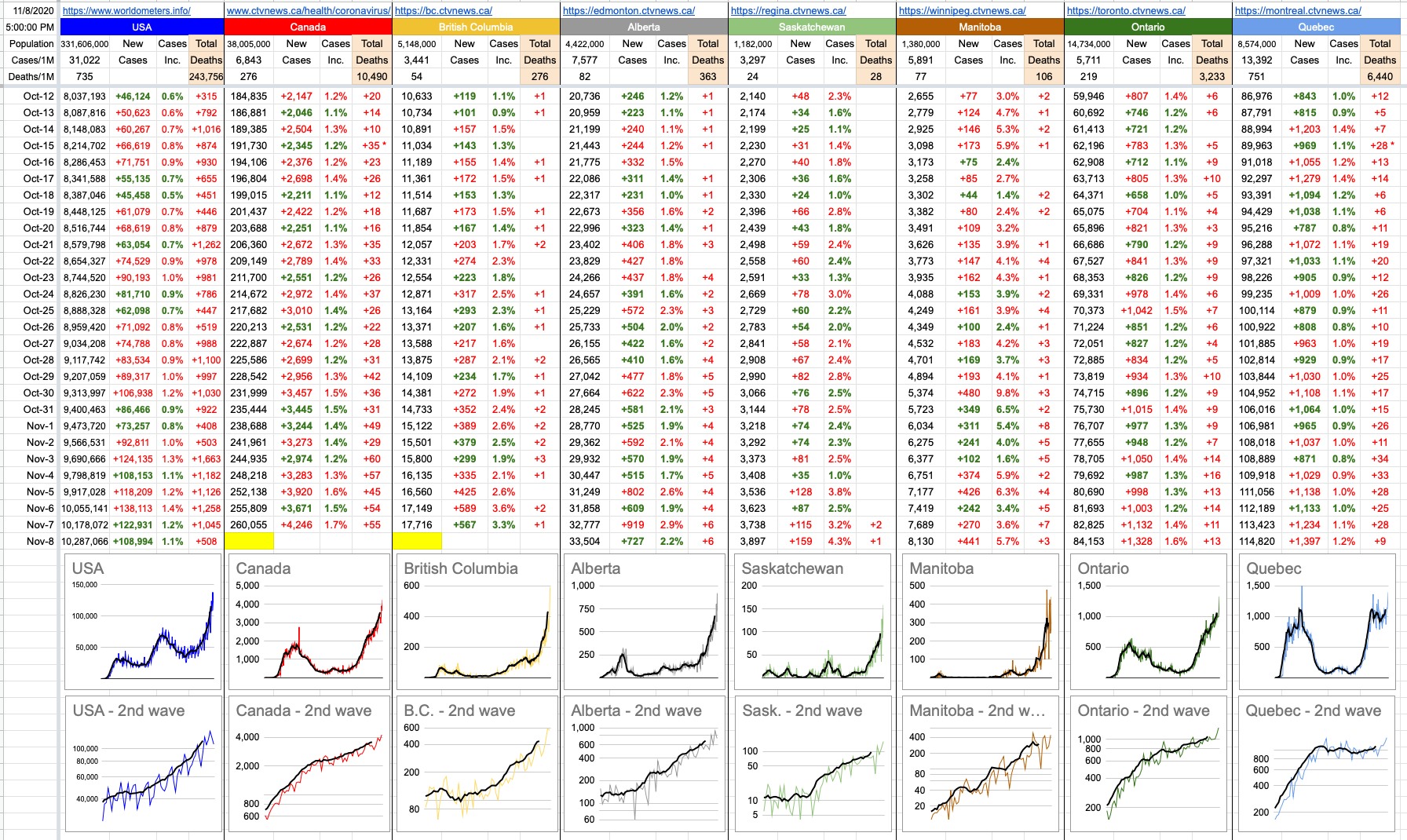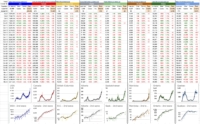Day 76 – May 31, 2020
Looking around the world for some good, optimistic news… we could all use a bit of that… I came across both France and Italy, both showing steadily declining numbers… and entering re-opening phases… a very welcome progression for those two places that were hit very hard.
One of the well-known symptoms of COVID-19 is how it affects the sense of taste and smell.. and that reminded me of amusing thought… due to an observation I had when I was in Paris in 1996. My girlfriend at the time was studying a year abroad at The Sorbonne, and I’d gone over to visit her for a couple of weeks. We didn’t have a lot of money to spare as we were saving money to go to Italy the following week, so we spent most days just wandering the streets of Paris, from park to park, coffee shop to coffee shop. And what struck me were two things; everybody smoked, and nobody picked up after their dogs. The streets were littered with cigarette butts and dogshit, and it occurred to me that the two things were connected. Most people didn’t realize now badly their city smelled, because all they could sense on a continual basis was cigarette smoke. Actively, stale or second-hand — you couldn’t get away from it.
And all of that reminds me of a funny story…
She lived in a tiny apartment above a coffee shop that she frequented, and on my first morning there, we went down to grab a coffee.
“Un latée, si vous plait”, I said to the shopkeeper/barista/older French guy.
“Monsiour, there is no such thing as a ‘latée’ — what you want is a café-au-lait. You Americans… you butcher our language.”
Whoah dude, what… jeez.
Typically, in that situation, the first thing I do is clarify the very relevant, important and proud point that I am Canadian, not American. But in that very WTF moment, what I said was… and I should point out, I don’t speak German… but having visited Berlin a few years earlier, I still remembered a few key words… and so what I found myself saying was,
“You know… if it weren’t for us Americans, I wouldn’t be asking for a latée… or a café-au-lait… I’d be asking for Ein Heisse Milch Kaffe.”
As you might imagine, that was not well-received. The look of genuine surprise on his face though, the way his eyes got all wide… his own WTF expression… that was funny.
“Get out. Don’t come back”.
Hell yeah man, we’re outta here, and we’re not looking back.
So that’s how you get banned from a French coffee shop. The girlfriend wasn’t too pleased, having had her daily coffee hook-up destroyed (it wasn’t, she went right back to it after I left), but that whole episode brought to mind that old saying that France is wonderful, except for the people. I don’t really agree with that; we met some great people on that trip and I’ve been back there a few times since. Always a great experience. Arrogant jerks come in all shapes and sizes, and you’ll find them everywhere.
And we did make it to Italy, near the end of the trip… near the end of the relationship too, in fact… due to episodes like that one, but also this:
The idea was to get to Venice, but it was going to be shoestring all the way. Staying in Venice was out of the question, but we found a cheap hostel in Padova, about a 30-minute train ride away. Cool hostel by the way… the rooms were all molded plastic. The bathroom — sink/toilet/shower — was one tiny molded room, and after you used it, you’d push a button and the entire thing — every part of it, would be thoroughly cleaned; a whole cycle of soap/rinse/dry.
So in the morning, we headed to the train station to catch the train to Venice. I don’t remember how much the tickets were in Lira (this was before the Euro), but it was roughly $14 for a 1st-class ticket and $12 for a 2nd-class ticket, and we got into a huge argument. I wanted to pay the extra $2, and she argued we didn’t need to. Come on it’s only $4, yeah but it’s throwing money away, yeah but jeez, for the experience, who knows when we’ll be back here, as if we’re ever coming back here together, etc. Finally, I had to cave because — well, does that even need explaining. In any event, she spoke Italian so she went to deal with it… she bought us two 2nd-class tickets and she guided us to the platform and onto one of the train’s 2nd-class cars.
And, I have to be honest. It was really nice. Plush, comfortable seats. Not crowded. Quiet. Air conditioned. Wow, I thought… this is great. OK, I was wrong.
Halfway through the journey, the conductor shows up to take our tickets. We hand them over. He frowns. No no, he says… not 1st class. Huh? Oh crap… we’re sitting in 1st class. Oops. Sorry, we say… we will move right away. No no, he says, wagging his finger at us… you pay. Oh… yeah, ok, we will pay. Ironic, I think… all that fighting for nothing; here we are. I’m prepared to pay the “upgrade”, except now they’re both arguing and she’s getting upset and eventually explains to me that no, we can’t just upgrade the tickets… we’re being fined. She’s crying, I’m yelling, and he’s telling us police will be meeting us at the other end if we refuse to pay the fine, on the spot. The fine was $40 each, which took our entire budget for the day. I’d been trying to figure out how we were going to eat, catch a chamber-music concert at some church, and go for a gondola ride with the budget we’d had. The problem was solved… we did none of that… just wandered the streets (and bridges) of Venice till we could walk no more. At least there was less dogshit to contend with.
Yes… this has little to do with anything; blame it on Dr. Henry and her lack of releasing numbers on Sundays. I will correct the numbers tomorrow, as usual, and hopefully have something more relevant to convey… but it seems to be a “flat-or-better” sort of day.
But for now, that’s it; the weather looks good… maybe go outside and take your dog for a walk. And pick-up after it.
View Original Post and All Comments on Facebook
Day 75 – May 30, 2020
Let’s start with the vastness of how incredibly big the universe is, like indescribably impossibly, unimaginably big. I’ve written about how our brains lose scale the bigger and more unrelateable the numbers get. But also, if you go the other way, things get unrelateably small. We think we can conceive of how small an atom is, but it’s way smaller than you imagine… and the building blocks that make up the nucleai of atoms… protons, neutrons…and other sub-atomic particles… way smaller… and quarks beneath that… it’s a long way down, all the way to the down to the Planck length… which is the scale at which classical ideas about gravity and space-time cease to be valid, and quantum effects take over. This is the “quantum of length”, the smallest measurement of length that has any meaning. It is roughly equal to 1.6 x 10^-35 m or about 100,000,000,000,000,000,000th the size of a proton.
It is estimated that the diameter of the observable universe is about 28.5 gigaparsecs (93 billion light-years, or 8.8×10^23 kilometres or, well, let’s spell it out… 550,000,000,000,000,000,000,000 miles), putting the edge of the observable universe about 46.5 billion light-years away.
If you look at the numbers in metric… I’m going to normalize these things to a unit we’ll define as a tenth of a millimetre… let’s call that unit… I dunno… a Kovid.
Why that particular length? Because it’s the mid-point between the biggest and smallest things in the universe. The universe itself is 8.8×10^31 Kovids wide… while the Planck length is 1.6 x 10^31 Kovids… which means the width of a human hair is the half-way point in size. Take the width of the universe… average it with the smallest width we can measure… and you get the width a human hair. It blows your mind no matter which direction you approach it from. We, here, in our 3D existence, are right in the middle of a scale that’s vastly incomprehensible, no matter how you view it.
This is the sort of coincidence that either means a lot, or means nothing… sort of like how if you observe the cosmos, you will notice that everything is moving away from us. Like, if there was a Big Bang, visualized as an explosion from a central location, we are right in the middle. That sounds profoundly meaningful until you realize that the Big Bang was not that sort of explosion… it was an explosion of time and space, and it’s expanding uniformly everywhere… like, everywhere in the universe looks like the middle of it, because everything seems to be moving away from it.
Interesting duality with both of those things, depending on how you look at it… either we, humanity, is really incredibly important in the grand scheme of things… or we’re an insignificant, irrelevant part of the bigger picture. It’s probably a bit of both, again… depending how you view it.
All of this came to mind this morning while watching a rocket launch — the first manned launch for SpaceX and their Falcon 9 rocket. It’s fantastic to see the new technology, which, if you’ve been following the evolution of SpaceX, is a slow and steady progression of very impressive engineering. I am in awe of these guys being able to take the exhausted first stage of a rocket, and recover it perfectly, landing it on a ship that’s waiting for it in the precise spot. And the space capsule itself, all operated from touch panels… no endless maze of confusing knobs and switches. It’s crazily impressive what mankind can do when it puts its mind to it.
It’s also tragically horrifying what mankind can do, as evidenced by the events that triggered the present evolving meltdown in the U.S. We make such progress on one hand, and it’s like we haven’t evolved from barbaric cavemen in others. Rocket fuel burns, taking mankind literally upwards, on a 19 hour journey to another technological marvel, the International Space Station… while on the ground, cities burn in protest and recognition of just how far other parts of society need to evolve. The vast spectrum between those two things seems as vast as my Kovid scale.
Shoutout to the two astronauts, Bob and Doug (how’s it going, eh…), and may they have a safe journey to the ISS — and back. And it’s interesting… for those guys, when they look out the window, they can see it all… the entire earth below them. The place where everything that’s ever happened… entirely in their field of view. How small we all are in the grand scheme of things, but at our scale, how large and important things seem. I bet if we could all see that view — take a huge step back… or, up, really… 400km up to the ISS… and look down, I wonder if we’d realize that we are all very much the same.
It’s suggested that everyone, especially when they’re young, go somewhere… else. Like, vastly different. There are plenty of places that need schools built and fresh-water wells dug and English classes taught… they need the help, and some people around here need a vastly different perspective. You certainly appreciate what you have here and what you take for granted when you see things through a different lens. I’d like to think that in the future, space travel will be so accessible that everyone might have the opportunity to at least spend a few hours in orbit, looking down. The grade-12 trip won’t be 2 weeks in Guatemala… it’ll be a trip to a launchpad, and then upwards… far.
Perhaps a few laps of the planet would make people realize that from up there, there are no visible borders and that the people below, whose cultures and skin colours can’t be seen from so far above, must also all be part of the same big picture. And maybe that’ll lead to less people being murdered, asphyxiated with knees to their necks. Or less people playing victim and trying to get someone arrested (or worse) because they’re offended at being told to leash their dogs.
Look at this godforsaken virus. It’s doesn’t care. It doesn’t differentiate. White people in Italy, Black people in New York, Asian people in China. It’ll infect and kill us all indiscriminately. But you can’t blame it. It has no brain, no consciousness, no empathy, no compassion. We humans have all of that, and if we can use it to advance humanity the way today’s launch implies, we can certainly use it to fix the rampant and evident ongoing societal inequalities that persist.
View Original Post and All Comments on Facebook
Day 74 – May 29, 2020
If you’re a flat-earther… stop reading now. But if you actually believe the earth is a sphere (it’s actually an oblate spheroid, a little flatter at the poles and bulging at the equator, because of the spin… but whatever…), then you may have wondered at some point… how fast am I moving? If you’re standing at the South Pole, the answer is… you’re not… you’re just spinning in a very slow circle, completing a full revolution once a day. The circumference at the equator is 40,000km, and a day lasts 24 hours, so the math is simple — you’re whizzing along at 1,667 km/h… a little over 1,000 MPH. Actually, you’re moving through space a lot faster than that… because the earth moves around the sun, and our solar system spins around the center of our galaxy… and our galaxy itself is also moving through space, at over 2 million km/h. There’s no better proof of the impossibility of time travel than that… even if you move back in time one second, you’d materialize in the middle of nowhere, out in space somewhere. OK, that was a tangent… where was I…
The city of San José, Costa Rica, is a little over 1,000km north of the equator, somewhere around the 10-11º latitude. What’s interesting about places close to the equator is how quickly the sun rises and sun sets. Given how fast the earth is moving at that spot, it makes sense. It goes from full sunshine to pitch black in less than 30 minutes, and same with sunrise, but the other way around. And how little sunrise/sunset times change throughout the year. Without exception, no matter what time of the year it is, somewhere between 5am and 6am, pitch black to brilliant sunshine. And sometime between 5pm and 6pm, the opposite. Every day lasts almost exactly 12 hours. They have no idea what it’s like around here, for it to be pitch black at 4:30pm on those miserable Winter days, or brilliant sunshine after 9pm (coming in less than a month!)
What’s also interesting about San José is the temperature variation throughout the year — or lack thereof. There are no hot or cold seasons… it’s all the same, year-round, and the temperature range is a narrow sliver. Over a typical year, the coldest temperature is around 18ºC (64ºF) and the hottest is around 27ºC (80ºF). That’s only a 9ºC difference, and if that’s all you’ve ever known, the temperatures near the edge of that range can feel extreme… which leads to the amusing situation some friends and I found ourselves in when we were there. We were staying in a nice place with a beautiful pool… and it was after dinner, already dark, but it was 18ºC out… more than suitable pool weather. So we’re in the pool, splashing around, having a great time… and there’s a security guard wandering around… in a full winter jacket, toque, gloves and ear-muffs. Looking at us like we’re crazy. And we’re looking at him like he’s crazy.
But that’s all he knows, and that’s all he’s used to, and 18ºC to him is like -20ºC to us… the very edge of super-cold.
And now you’re wondering what this might have to do with this pandemic (I was going to say “global pandemic”, but every time I do, my son corrects me… “As opposed to what, dad… a neighbourhood pandemic?” — OK, it’s a pandemic… it’s global. And it’s very straightforward… it’s making us look at things differently, for us — but things that for certain people are a way of life, because they were already used to it.
Indeed, I think for a lot of people, adjusting to the new-normal has been a bigger shock, the more complicated their previous life was. Because really, the simpler your life was before, the easier (if any) adjustments you had to make. Some remote village where people live self-sufficiently, grow their own food, fish, raise chickens… they’re barely, if at all, affected. There’s that lingering thought I keep having about simplifying life in general, because now that things are starting to open up, my old life is pulling me back in, and I find myself resisting a bit.
We’re still far from the end of this, and we’re all itching to bring back at least some degree of familiar normalcy. It’ll be a far cry from the real thing, which is coming one day… on the (hopefully not too) distant horizon… but even when things are 100% back to normal, I hope we can hold on to some of the not-so-normal, that was imposed upon us… because it’s not all bad. I certainly hope so. I’m trying.
When I told some guy in Costa Rica that it sometimes doesn’t get dark until after 9pm here, he was startled… and he asked, “What do you do?”. What an interesting question… what do you do with all that extra daylight. Well, the answer, I suppose, is you make the best of it. Much like we’ve all been making “the best of it”. But hopefully we’ve learned something that carries through; something that was very new to us, but blatantly obvious to someone else, someone from whose life we had something to learn, even if we didn’t know it before.
View Original Post and All Comments on Facebook
Day 73 – May 28, 2020
The whole “too many chefs in the kitchen” or “too many cooks spoil the broth” — the thought behind it applies to pretty-much everything in life. Certainly, from experience… having been both the guy being told what do do — and the guy telling others what to do — I strongly believe in it.
One key to success — again, in many facets of life… and I’ve said it often… surround yourself with capable people and let them do their thing. This means understanding that they will do things… differently. Compared to what you would’ve done, it might be better or it might be worse… but it’ll certainly be different. The thing is, as long as you were right — that they were the right person for the job, capable of doing it — it should turn out alright. And this doesn’t mean that person is the one who does everything; it’s just clearly understood that the entire thing, no matter what it is… they answer to it. They can delegate jobs, hire extra people, whatever… but it’s up to them.
The chef/kitchen thing is a great example, actually. One can only imagine the chaos a large-scale kitchen would endure if multiple bosses were screaming out orders. There is a hierarchy, and at the top of it is the head chef. There may be a sous-chef, a pastry chef, a number of others… and multiples thereof. But there is a well-defined tip of the pyramid.
On one particular day… around 20 years ago, three former premiers of this province were all in Provincial Court on the same day. A complete coincidence… Bill Vander Zalm with his Fantasy Gardens scandal, Mike Harcourt with his BingoGate scandal, Glen Clark with his casino-license-for-deck-repairs scandal…. all there for different reasons, but all there to face the music with respect to abusing the public trust in some way, scandals that drove all of them out of office. That’s a SoCred and two NDPers, but corruption crosses all party lines. Subsequent to that came Gordon Campbell, Liberal, ultimately driven from office by the BC Rail Scandal. What is it with B.C. and our elected premiers? Scandalous.
I guess I’m relieved that the guy in charge these days isn’t some wild-west shoot-from-the-hip sort, doing whatever he pleases for personal gain. That would be a disaster in this present climate. John Horgan picked the excellent people with whom to surround himself, Adrian Dix and Dr. Henry, and he’s letting them run with it… and they were the right people for the job, and they continue to deliver outstanding results. This is textbook good management and proper delegation, and we in this province are very fortunate to have it.
Can you imagine a scenario where first Dr. Henry gives her daily update, then Adrian Dix gives his, and then The Premier stands up and discounts all of it? Questions their numbers, questions their strategies, makes up some stuff to suit his narrative? Suggests we ignore what we just heard? What a nightmare for the people listening and trying to figure it all out. That’s perhaps the biggest blessing around here, and perhaps the biggest differentiator than many other places; at the end of the day, our response is being led by a scientist, not a politician. On paper, Dr. Bonnie Henry isn’t the top of that pyramid, but in every other practical sense, she is…. and the consistent messages we get on an almost-daily basis, and their transparency, may well be the biggest reason we’re doing so well around here, compared to even other parts of Canada, where the response has been driven by politicians.
The corruption aspect — at the expense of the greater good — is nowhere clearer than in some of the head-scratching decisions we have seen being made elsewhere. The push to open gyms — enclosed spaces of people breathing heavily and touching many common surfaces? Sure, they have to open eventually… and around here, some are — under strict regulation. But in places where numbers are still rising? You have to look no deeper than the political connections and influence being imposed. That was the easy and obvious part to understand. Political business as usual. Like everywhere. Except the stakes aren’t money; they are people’s lives.
And now, there’s a more serious problem… some of those governors, intelligently ignoring the confusing and conflicting directives coming from higher up, are imposing their own orders… and many people are simply ignoring them, choosing to listen to whomever is in charge, somewhere up there — that agrees with what they want to hear. Many businesses, gyms among them, in numerous states… will be (if they’re not already), defying their respective governor’s orders to stay closed for now. Business as usual.
What a mess, from so many different points of view… legal, health, practical. And when it all goes to hell, the fingerpointing will be fierce. Sure, the mayor said we should’t open, but the governor said it was fine. Yeah, the governor said we shouldn’t open, but the president said it was ok. Unfortunately, those mixed messages may come back to haunt them.
View Original Post and All Comments on Facebook
Day 72 – May 27, 2020
As per usual, researching things leads to interesting facts. What do you think is the driest place on earth? I always thought it was the Atacama Desert in Chile, but turns out it’s in second place… to an area in Antarctica where it hasn’t rained in somewhere between 2 and 14 million years. You’d think you could safely assume there isn’t much life around there… but there actually is. Way underground, inside the rocks… bacteria that feed on iron, potassium and sulfur. And, for those bacteria that aren’t doing keto (or cheat a bit sometimes), carbon.
I can attest to the dryness of the Chilean desert because I lived there. In the driest parts… the further north you go, the drier it is. Some weather stations record 1mm of precipitation a year. Some have never recorded any.
Where I lived, Copaipó, a bit further south than that, rain was rare enough that it was talked about like a big event… The Big Rain of ’85. Part of the reason it’s such a big deal is that every single place around there spends zero on mitigating it. No drains, no gutters. So when it rains, it’s an unmitigated disaster. Everything floods. Everything… because there’s nowhere for the water to go. People will be sweeping water from their homes into the street. The streets are a flooded mess of mud. Eventually, often sooner than later, the sun comes out and it all evaporates away, leaving the usual Martian landscape. And a huge mess to clean up.
Though, it should be noted, and this is super-cool because it’s so rare… there is some version of suspended life under the Atacama desert — seeds just waiting for their one chance. They wait decades for their one big moment… and then it comes… and the desert flourishes with life for a few hours — an incredible array of colour, albeit briefly. That happened in 2015, and it was spectacular. But also, it was more rain than they’d possibly ever had… almost an inch of water fell… and caused massive flooding and landslides, killing 25 people and leaving thousands homeless.
The ability to count on no rain leads to some interesting possibilities. Very few people had a dryer; clothes-lines everywhere. And.. there was a road up in the mountains made of salt… and when you think about it, cool idea… salt water is free (Pacific Ocean is nearby), and all you do is lay it down and let it evaporate. What’s left is salt. Then you do that again… and again… till you have a nice bed of salt…then crush it with one of those Looney Tunes machines with the rolling drum… and voila, salt road. Every once in a while, top it up and flatten it out, and you’re good to go for years. Until it rains and completely destroys it, washing it all away.
Those two examples are just a couple of many of the sort I’ve talked about before; what’s normal and expected here can be very different elsewhere in the world.
And it’s becoming evident that you don’t need to travel 14,000km south of here to find them. They start just south of the 49th. And no, I’m not going to turn this into a Republican/Democrat thing, at least this time. Enough of that for now. Chile is doing what they’re doing because it makes sense to them. That’s how they’ve built their culture, one that’s been around longer than Canada and the U.S. combined. The U.S., of course, in their terribly-mismanaged responsibility-deflecting fashion, are doing the same.
For all the mistakes Canada may have made in what’s an incredibly complex situation, at the end of the day, numbers don’t lie. We are looking at a national trend that’s very encouraging. We’ve seen two straight days of less than 1,000 new cases. The last time that happened was in late March, when things were headed in the wrong direction. Last 5 days in Canada, from 5 days ago to today: +1156, +1141, +1078, +1011, +937, +872. That’s a trend. B.C.’s numbers are so low, there’s no way to define a trend. +10, +7, +6, +11, +9. It’s like the trend would be skewed by the time of day the test was taken, and whether the result counts for today or tomorrow.
Anyway, that’s what we're doing around here and across the country. And I like it.
View Original Post and All Comments on Facebook
Day 71 – May 26, 2020
There’s an interesting footnote about that Spanish Flu pandemic of 1918… which is the age distribution of deaths. For COVID-19, the median age of mortality is… well, it’s high. Depending where you look, it’s almost always north of 80. The younger you are, the better your chances… all the way down to zero, where except in extremely rare cases, often associated with other contributing factors, pretty-much anyone under the age of 20 looks safe from developing any serious symptoms.
A lesser-discussed pandemic is the Russian flu, which ran over a period of 4 years, peaking around 1890… and ultimately killing more than a million people worldwide. Its mortality profile is similar to COVID-19 in that it was far more dangerous for the elderly. But also, a big difference… is that it also killed a lot of very young people. The mortality rate for ages 0 to 10 was similar to those somewhere in the 40-60 range. The 10-30 age range was the least affected… and those over 70 were more than 20x likelier to die than that 10-30 group.
The 1918 pandemic hit the young people the hardest, a puzzling question that’s still being discussed, and there are very different ways of approaching it. The worst age to be for that pandemic was 28 — that was the highest-mortality age group. One common thought is that those who survived the 1890 pandemic built immunity, and were far less affected in 1918. But another interesting analysis starts with some simple math… 1918-28 = 1890. Indeed, those who survived the 1890 pandemic as infants… whether just born or perhaps still in utero — they were the ones hardest hit 28 years later.
To further confuse the issue, while it’s established that 1918 was without a doubt influenza (H1N1), there are some theories that 1890 wasn’t actually a flu, but a coronavirus… which obviously means that the theory of acquired immunity for older people can’t be correct, and that perhaps some drastic effect on the immune system of infants took place during a critical time of development.
Such are the sorts of things I learn when I fall into the Google spiral of doom… setting out to research something, and winding up very far away… and you all know how that can go… even here on Facebook, you log in to just send a quick message to a friend, and 20 minutes later you’re looking at wedding pictures of people you’ve never heard of.
What I started with today has to do with headlines like this:
“Coronavirus cluster linked to pool party” (Arkansas)
“Several members of a Franklin church test positive for COVID-19” (North Carolina)
“A second hairstylist potentially exposed 56 clients to COVID-19” (Missouri)
When I started writing this today, the American death count was below 100,000. As I prepare to hit [Post], it’s now over…
Some American states violently threw the doors open at the start of May — so now we’re seeing not just the initial effects, but the secondary ones as well. With an incubation period of 5 to 14 days, we’re perhaps even seeing the beginnings of a third. So how does it look… well, in 17 states, the numbers of new cases are trending upwards… among them Arkansas, North Carolina & Missouri. And Georgia. And Alabama. It’s really not a big surprise to see where things aren’t headed in the right direction. And there’s no reason to single out the U.S. — we’ve all seen those pictures from that park in Toronto a few days ago. I went for a great bike ride today, and my usual ride would have taken me down the Arbutus corridor, down to the water, and around the seawall… with a lap of Stanley Park if time (and regulations) permit. But I avoided all that, because I didn’t want to be anywhere near the sort of crowd I imagined I’d find.
The vast majority of people whose behaviour really makes you wonder… are younger. Because, you know, they’re invincible. And I don’t mean to single out an entire generation or two as irresponsible; it’s just what I happen to observe around me.
And when you think about it, I’m double their age and even I can’t really say I’ve suffered through any global health crisis that’s affected me. I’m old enough that certain vaccines didn’t exist when I was a kid, so I, along with most of my peers, suffered through chicken pox. The MMR vaccine showed up a few years after I was born, which means I missed the ideal window to have gotten vaccinated. I did, of course, as soon as it made sense… but anyone younger than me… they’ve largely been immune from birth… to diseases which, not that long ago, would’ve been affecting — and possibly claiming the lives of — friends all around them.
“The risks are for the history books and life is meant to be lived and we’re not really at risk, etc etc.”
It’s not a great attitude, in general… and it applies to everyone who thinks for some reason we’ve made it free and clear to the other side. We haven’t, yet. Opening up doesn’t mean throwing caution into the wind.
View Original Post and All Comments on Facebook
Day 70 – May 25, 2020
Yesterday’s post was met with a wide range of reaction, and the questions and comments lead me to think a bit of clarification and more detail would be appropriate. Some of those comments came from Swedes themselves, a little bit upset at being painted somewhat ruthlessly; to clarify, I’m speaking about leadership and their policies; not the general population, many of whom don’t agree with the official policy in the first place. And to also clarify, I’m not implying their leadership and epidemiologists are evil. They simply came up with a strategy, and it’s not working as they’d hoped. So, här är del två…
I first wrote about Sweden on April 10th… more than 6 weeks ago. I welcome you to scroll down and find it — it’s a pretty good summary of where things stood at that point, what measures where (and weren’t) in place, and what I thought of the whole idea. And sure, “What do you know?” is a fair question to ask of me… especially 6 weeks ago. We’re all continually asking the question of each other, and hopefully learning something. That same article also mentions a famous letter signed by more than 2,000 Swedish doctors, scientists and professors… the contents of which can be summarized succinctly as it relates to government policy (which hasn’t changed): “They are leading us to catastrophe”.
First of all, let’s clarify exactly what is meant by herd immunity.
Herd immunity is where enough people of a population are immune to the extent that the infection will no longer spread within that group. The more infectious a disease, the higher that percentage has to be. For example, mumps is very contagious. It has an Rø of 10 to 12, meaning every infected person will infect, on average, 10 to 12 others. Left unchecked, this would lead to 95% of the population getting infected. After that, the population can be considered to have acquired herd immunity, and the other 5% will inherit the benefit of that… because at that point, there’s no one left to catch it from. Measles has similar numbers. That particular herd-immunity threshold is very high, and can only be reached via vaccination because allowing everyone to catch either of those horrible diseases is not an option. And these days, completely preventable.
With the way the math works, the higher the Rø, the higher that herd immunity threshold. For COVID-19, estimates seem to run between 1.4 and 3.9. Both of those numbers seem extreme, but for the record, they imply a range of 29-74% to achieve herd immunity. An Rø of 2.3 seems to be generally accepted, implying herd immunity could be achieved with 57% of the population having become infected.
Is that likely in Sweden? Anywhere?
Before we answer that, it’s worth noting that the policy-makers in charge in Sweden have been backing away from claiming this was the idea in the first place. It’s a mixed message for sure, and it’s changed over time. I think it’s reasonable to assume it was the original intent; shelter those most at risk (an impossible task, but that’s also a different discussion) and then let the virus do as it may. But, to confuse things a bit, while businesses were to be open, a vast number of Swedes, not too different from Americans in some confused places, said to hell with what the government tells us; we will take our lead from others, perhaps like those 2,000 who signed that letter.
That’s intelligent on their part, but certainly affects the plan of “get the virus out there”. You can’t have it both ways, and perhaps you end up in a purgatory of sorts… where there’s too much illness to be handled properly, but nowhere near enough to be even close to establishing herd immunity. Indeed, by an order of magnitude, nobody on the planet is even remotely close. What do we need? 70% 60%? I’ll give you 50%. What’s Sweden at? Maybe 9%. More likely closer to 7%. And let me clarify… I am in no way blaming Swedish society for not doing their part; I’d have done the same thing, isolating myself and not frequenting crowded places. Even without any sort of lockdown, achieving herd immunity was not going to happen. Even if it were possible, it’d take years. To be sure, there are a lot more people who’ve been infected than we know… but still… that Stanford study that implied infection rates 50 to 85 times higher than thought… there are problems with that study, but let’s take it at face value… where are we at with that, near San Francicso? 2%. Nobody is even close to herd immunity, and it’s likely nobody will get there. Of course, a vaccine achieves that instantly, and that’s why we’re diligently aiming in that direction.
That sad thing about Sweden is that they could’ve seen it coming, but did nothing to prevent it. The U.K. tried this strategy… shelter the weak, keep things open, weather the storm… and bailed on it around March 17th. The U.K. was only at around 2,000 cases, but it was the drastic nature of growth that led them to quickly understand how bad this could get. Sweden had seen its 1,000th case by then, but it wouldn’t have been too late to re-evaluate then. Or the next day. Or any of the 40+ days since.
There is a discernible and not-too-surprising pattern emerging around the world; here are the worst three countries… for total cases, and daily new cases. In other words, not only have they seen the most cases, but they’re all still growing — faster than anyone else: U.S., Brazil, Russia. What do they have in common? Here’s a hint: Trump, Bolsonaro, Putin. Try changing those minds.
The Prime Minister of Sweden, Stefan Löfven, is no renegade populist. He’s a social democrat. And he’s dealing with a population of only 10 million people. It’s not great now, but it’s not too late. I wrote recently about the joys of being wrong, and the opportunities it affords. Perhaps it’s time for Sweden to give it some thought.
View Original Post and All Comments on Facebook
Day 69 – May 24, 2020
No updated numbers for B.C. today, so, as usual… I’ll make an intelligent guess and fix it tomorrow.
So let’s talk about yesterday’s numbers, and let’s begin with the old “5 blind guys and an elephant” parable. The premise of it is straightforward… these 5 guys have never encountered an elephant, and each reach different conclusions about the different parts of the elephant that they touch. The guy who grabs a leg describes it like a tree trunk. The guy who grabs the tail describes it as a rope. The guy who grabs an ear describes it as flat and floppy. The other two guys… one grabs a tusk, the other grabs the trunk. Their interpretation and discussion with each other is outside the scope of this post; we’ll leave Freudian experts to discuss their conclusions.
The moral of the story actually changes, depending on what lesson you’re trying to teach. Maybe that vastly differing opinions are all justified when talking about the same subject, like someone else’s opinion is just as valid. Maybe that sometimes, we’re fighting about the same thing. Maybe that we need to question our method of questioning. In some versions, the guys aren’t blind; just in the dark. But once they’ve “seen the light”, they all agree.
Let’s go with something like that… the guys aren’t blind, just initially blindfolded… but were convinced by their first impressions, especially because they went around telling everyone, and in doing so, convincing themselves that their version was “the most correct”. Indeed, even after the blindfolds were lifted, and they could see the big picture, they still clung to their beliefs… perhaps since they were already so invested. And, to add a bit more to it… once they could see, they realized that they were actually in an elephant park… with lots of different elephants. And, all of the elephants had been given names… of places, like in that series “Money Heist” (side note: watch Money Heist, and watch it in Spanish, with subtitles… incredibly good.. it’s on Netflix).
So these elephants… there’s one off in the distance… her name is New Zealand. She’s tiny, but looks very healthy. There’s one called Canada, who is really big and, for the most part, looks ok — parts of him looks much healthier than other parts, but he’ll be fine. There’s an elephant called United States… poor thing is really beaten up and needs to rest, but some trainer has a rope around him and is literally trying to drag him onto his feet.
But the elephant these guys had all initially touched and reached wildly different conclusions about… his name is Sweden.
Let’s pause here and be perfectly pragmatic. Without any opinion yet, here are some numbers, and a bit of comparison… of two places in the world where lots of people insist things are going really well: Sweden, and British Columbia. Starting points can be arbitrary, but for what it’s worth, both places had the same number of known cases (7) on Feb 27th. Sweden accelerated upwards far quicker than BC, and here’s where things are at, as of yesterday:
Population: BC 5.1M, Sweden 10.2M (2x)
Testing rates: BC 21.6 people out of 1,000, Sweden 20.8 (~same)
Known cases: BC: 2,517, Sweden 33,459 (13.4x)
Deaths: BC 157, Sweden 3,998 (25.5x)
Active cases: BC 303, Sweden 24,490 (81x)
Resolved cases recovery: BC 92.9% recovered, Sweden 55.4% recovered
Resolved cases deaths: BC 7.1% died, Sweden 44.6% died
Last 3 days: BC +40 positive tests, Sweden +1,665 positive tests (41.6x)
Last 3 days: BC 7 deaths, Sweden 161 deaths (23x)
I was chastised for stating somewhere that Sweden is letting their old people die. OK, I will clarify… they’re not letting their old people die; they’re letting everyone die. And by that, I simply mean they’re letting the virus run its natural course through the population, taking down whoever is unfortunate enough to contract the serious symptoms that might show up. The demographic profile of who’s actually dying is similar in both places, it’s just that for every elderly BC resident that passes away, 25 pass away in Sweden. That is the cost they’re willing to bear to keep the economy going, and there are undoubtedly people who’ll look at all of that, the same elephant I’m looking at, and come to a completely different conclusion as to what’s success and what isn’t. At some point, this is purely about opinion. The numbers speak for themselves, and you’re free to interpret them however you wish.
Yes… the measuring sticks of success are different, for different people. I don’t like to dwell in the purely pragmatic world, because it leaves out many things I consider very important and are part of my core values. Purely pragmatically, if you’re worried about economics, letting old people die makes sense. Same for sick or disabled people. The moment that the carrying-cost of someone’s existence outweighs the benefit, economically, to society, we’re throwing money away. Care homes? Wheelchair ramps? Braille on signs? Feeding into old-age pension plans? Think of all the money we could save.
A little over 80 years ago, around 1,000km south-west of Stockholm, there emerged a madman with that sort of agenda. Off he went, trying to rid his society of who and what he deemed undesirable, in the name of his version of the greater good. I wonder if perhaps the deep personal attachment I have to that particular historical event skews my objectivity, but on the “lives vs. economy” scale, I am very heavily tilted towards the “lives” side. Notwithstanding that without lives, you don’t have an economy anyway.
The few family members who managed to survive The Holocaust came out of it with very little, except each other, and that’s what I keep thinking about when this discussion comes up. Lives and family first, economy second. Elephants never forget… and when it comes to this, neither do I.
View Original Post and All Comments on Facebook
Share...
November 8, 2020
The effects of the 2-week restrictions that went into effect 19 hours ago won’t really be known till the end of that time period… so until then, we’re in a bit of a wait-and-see. It’s interesting to note that I’ve was typing out almost the identical sentiments back in late March… for example… https://kemeny.ca/2020/03/27/march-27-2020/
There’s really no difference except the numbers are far more frightening now, considering the potential trends. This could blow up horribly within these two weeks, and looking around at the rest of the country, there’s little about which to be optimistic. It’s not a question of whether it’ll get bad. The only question is to what extent. If it’s any indicator, I’m sad to report that Nunavut’s shutout has been broken. Their two cases aren’t much, but they’re no longer at zero.
Similar to the Covidiots down south who have a mushed-up (and messed-up) version of reality that combines conspiracies, freedom, vaccines, masks and hoaxes and, now, election fraud, closer to home, we have a bunch of “freedom-fighters” holding rallies across the country. Yesterday it was in Ontario. Today it’s on Vancouver Island. It’s incredibly annoying.
With Remembrance Day just around the corner, and keeping the heroes that died for our actual freedom in mind, instead we get clueless morons who think they’re making a monumental statement against government oppression by livestreaming their defiance of not wearing a mask on a BC Ferry… like I keep saying, I wouldn’t care if the stakes weren’t so high. Go stand on your soapbox outside the art gallery and tell us all how Bill Gates is trying to control the entire (flat) world by injecting us all with G5 trackers or whatever; just don’t impose your nonsense on people who can’t defend themselves against it. I sincerely hope one day soon that the band of crazies is once again free to voice their opinions without it potentially affecting us all.
Until then… I don’t have a great answer except that maybe it’s time to clamp down a little harder on those that not only ignore the rules, but flaunt it as well. Freedom also means everyone else’s right to not have these selfish fools imposed upon us.
… [Continue Reading]
November 7, 2020
There’s that moment in “The Wizard of Oz” where everything goes from black-and-white to colour. It makes quite an impact…and to a great extent, for a lot of people, that’s how it feels today; a four-year journey of black vs. white, right vs. wrong, us vs. them… finally coming to an end. We are once again surrounded with colour. Isn’t it beautiful?
Nearing the end of that movie, Dorothy and her entourage finally come upon The Wizard himself… and pull back the curtain to reveal that he’s no wizard after all… just a fraud, pulling some levers. Far from a wizard… he’s just a failed showman.
But this is where the similarities end. The wizard gracefully exits; he leaves The Scarecrow in charge of Oz, with The Tin Man and The Lion at his side. A very elegant transfer of power. Then he gets into a hot-air balloon, and flies off to live happily ever after.
Our present fraud-wizard-failed-showman won’t be leaving quietly. The hot-air balloon would be a helicopter in this case, but on January 20th, there’s a relatively good chance Trump won’t be on it.
What’s becoming interesting is the method with which the rats are leaving the sinking ship. For four years, they agreed with, acquiesced to, and validated – his narcissistic venomous bullshit. Now they don’t have to. In many cases, these are people with similar personality profiles, so now what? They arguably played along because it served their purpose; stay on his good side or find yourself with a figurative knife in your back, exiled from the kingdom of Trump. That’s no longer the case. In fact, Trump himself has been pissed off for the last few days, wondering why none of those people are Tweeting their support for their soon-to-be fallen leader. The answer is pretty simple; they’re looking out for themselves at the expense of others… a lesson they learned from Trump himself. It’s time to jump ship.
What’s also not black and white is what’s going on here… it’s red… as in cases across the board in Canada… as per below, so… much… red. All rising… sharply. Red alert.
Dr. Bonnie spoke earlier today and imposed new restrictions, in place for two weeks, effective as of 10pm tonight, affecting social gatherings, travel, indoor group exercises and workplaces. And, … [Continue Reading]
November 6, 2020
To follow-up briefly on yesterday’s poker analogy… we’re at the point where Joe Biden went all-in, and Donald Trump, hesitatingly, called… so Joe flipped over his cards; what’s colloquially known as “the nuts” — the unbeatable hand, because there’s nothing left to deal that can change anything. Trump is drawing dead, and can only helplessly watch the hand play out.
Normally, a player in Trump’s position would realize he’s beaten, flip over his cards, and watch the chips get dragged over to the other side of the table. But, of course, Trump is trying to bluff an unbluffable hand. Perhaps at some point, his fans cheering him from behind will be able to convince him to just face the fact that he lost, and move on. But it’s doubtful. Many of them continue to cheer him on blindly.
Notwithstanding that this may end up being a bigger victory for Biden than was originally thought a few days ago, there are a lot of posts from people wondering how it’s possible that a misogynist racist narcissist whose policies have further divided a country the desperately needs unity – not to mention his abhorrent handling and messaging of this pandemic – could have received so many votes? There are many takes on it, but it boils down this…
First of all, some simple math… rough numbers, some 144 million people voted. Of those, there is an unshakable core of Republicans who’ll vote that way no matter who the candidate. How big is that core? It depends how you measure it. Here’s a rough breakdown of Trump voters:
American Preservationists (20%)
Staunch Conservatives (31%)
Anti-elites (19%)
Free Marketers (25%)
Disengaged (5%)
Within that breakdown, there are probably 40% who won’t be swayed, no matter what. And 40% of 144 million is around 57 million… so really, perhaps it’s only 13 million who “really” voted for Trump… and the vast majority of those are white men, and it must be noted that the urban voter turnout is what probably made the difference. The People Of Colour… Blacks, Latinos, Indigenous peoples… they showed up. In person, waiting hours to vote… or mailing it in… however they did it, they showed up. It’s no surprise that even in many Republican states, the big cities are hubs of blue votes.
On the flipside, the rural areas, many … [Continue Reading]
November 5, 2020
We often hear that it’s all about the journey, not necessarily the destination. But there are definitely situations where that’s not the case. For example, in poker, I might have the best starting hand… let’s say a pair of Kings. And you have a pair of Queens. Excellent; I manage to get all my money into the pot, and sit back patiently waiting to collect all of your money. I am a 4-1 favourite. I will win this hand 80% of time.
But then… the flop of three cards contains a Queen. What? Why me, always me, just one time… jeez… agh… then turn card is dealt and it doesn’t help me, and now I’m standing up and packing up my stuff, getting ready to leave… and then… King on the river. Boom. I sit down. You go home.
Quite a rollercoaster ride, but… I had the better starting hand, and I had the best hand at the end. What happened in between, who cares. The journey was irrelevant. It’s all about the destination.
And the U.S. election… before it, Biden was heavily favoured to win. As it stands now, it looks like he will, though nowhere near as powerfully as some imagined.
One day, elections… and, specifically, vote counting… will enter the 21st century with the technology available to make it completely trusted by everyone and, more importantly, instantly tabulated. At 7:00:01pm PDT, the electoral map of the United States will light up, reds and blues dutifully coloured in, and a declaration will be made with respect to who was just elected president. That is the indented destination, and it would sure change the journey, and everything that comes with it.
As I write this, the journey continues. The destination has yet to be reached. Biden is presently ahead by almost 4 million in the popular vote, 73M to 69M. On that magical journey to 270 electoral votes, it’s presently 253 Biden / 214 Trump. What’s interesting is that given the trends of what’s left to be counted, this could easily wind up above 300 for Biden. I’m imagining a very plausible 306/232 win.
I say all this because if that turns out to be the case, it’s more of a statement than first appeared. It’s not so squeaky close after all. But this agonizing … [Continue Reading]
November 4, 2020
Yogi Berra liked to say, “It ain’t over till it’s over”. The more sophisticated version of the same saying is… “It ain’t over till the fat lady sings”.
That not-so-PC saying is referring to Brünnhilde, — usually cast as plus-sized soprano — who, after 15 hours of opera (German composer Richard Wagner’s “The Ring”, a 4-part mini-series) has a 20-minute dramatic finale before finally (and spectacularly) burning to death. A somewhat appropriate finale for whatever happens next.
And a somewhat appropriate comparison in that Richard Wagner actually has a lot in common with Donald Trump… numerous affairs, horribly in debt, and terribly racist. Hitler was a big fan. Trump might be as well, though I don’t get the impression that the president gets out to many operas.
So no, it’s not over, though it’s trending against Trump at the moment, and, as expected, he is fiercely lashing out, trying to hold on to the presidency. It was interesting to hear the commentary on CNN late last night, just before Trump spoke, the CNN panelists speculating on what Trump might or might not say. Do you think he’d actually come and question the integrity of the election? Do you think he’d threaten lawsuits? And do you actually think he’d come out and claim victory?
Come on… after four years of this, how can you even discuss it? Of course Trump came out, and did exactly all of that… and even threw out that he’d get the Supreme Court involved.
You know what… I hope he does. I hope he tries, anyway… because one of two things would happen. The first, and by far the likeliest, is that the SCOTUS will tell him to go to hell. Go away with your frivolous nonsense. Every single vote will be counted, period. And that would be a powerful and appropriate send-off to the man who, for four years, tried to stack that court in his favour. Forget the right-wing conservative-leaning court he left in place; he doesn’t care about that. He cares about himself, and counted on these people to save him. And they won’t. Or, at least, they shouldn’t. It would be a final and decisive goodbye, even after the near-corrupt and very hypocritical installation of the latest associate justice.
Or… once again, Trump fools us all and gets … [Continue Reading]


